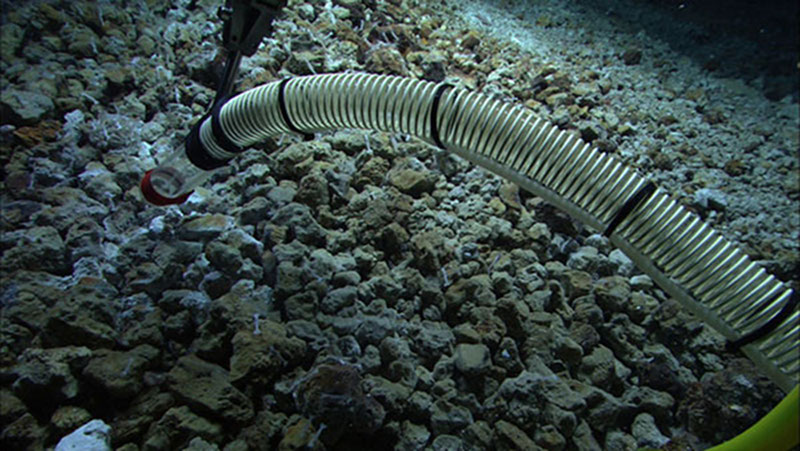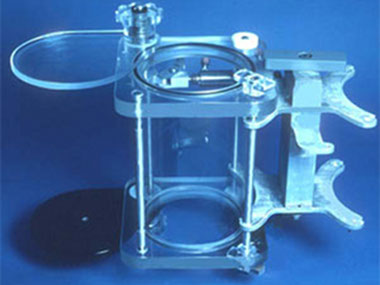Submersible Collectors
Many components make up a successful research submersible. Whether it is a manned or remotely operated vehicle (ROV), it must be able to withstand the high pressures of the deep-sea environment; be highly maneuverable; and be able to collect data and samples from the ocean depths for scientists to examine back at the surface. The suction sampler and detrital sampler were designed to attach to different types of submersibles and collect many of the unique and fragile organisms found only in the deep ocean.

The Quest 4000 remotely operated vehicle collecting biological samples with suction sampler during the Submarine Ring of Fire 2012 expedition. Image courtesy of MARUM, University of Bremen and NOAA-Pacific Marine Environmental Laboratory. Download image (jpg, 118 KB).
Suction Sampler
The suction sampler or “critter getter” is one of the tools employed to collect large, semi-fragile zooplankton from an ROV or manned submersible. The system is, in effect, an underwater vacuum that collects animals under gentle suction and deposits them into a 6-liter (1.5 gallon) canister.
The lid of each canister consists of an intake and exhaust door. The exhaust door is preceded by a fine mesh screen that prevents the animals from leaving the bucket. The spring-loaded canister doors are open only when directly beneath the suction head and are closed automatically when the canister is rotated from beneath the suction head. A total of 12 canisters are rotated on a large aluminum carousel, allowing each canister to collect separate specimens.
During collection, the pilot maneuvers the vehicle so that the animal is close to the sampler's front funnel. The force of suction varies depending on the speed of the animal being captured. Once the animal enters the three-inch-wide suction tube, suction pressure is quickly reduced so the specimen enters the canister at a relatively slow speed. This safeguards against the organism being damaged. A small video camera watching the canister allows the scientist to know when the animal enters, so that the suction can be shut off and the bucket rotated out of the active sampling position by a hydraulic piston.
When the funnel is removed, the suction sampler can also be used to collected smaller benthic (bottom-dwelling) organisms. In this mode, the suction nozzle is generally mounted on a manipulator arm, and moved into sampling position as needed.
"D" Sampler
The detrital or “D” sampler is also employed to collect large, semi-fragile zooplankton. It is the only suitable tool for collecting the most fragile specimens without damage and was originally designed to collect marine "snow" and other detritus.

The detrital or "D" sampler with both of its lids in the "open" position. Image courtesy of NOAA. Download image (jpg, 23 KB).
The sampler consists of a tube with doors that slide horizontally. The standard design holds approximately 7.5 liters (2 gallons) of water. Models also exist that hold at little as three and as much as 25 liters. The lids of the sampler are opened and closed by a hydraulic piston. An O-ring seal and heavy springs keep the containers watertight as they are lifted from the depths.
During collection, the pilot maneuvers the vehicle so that the target animal is immediately above or below the sampler. Both of the tube's doors open, and the vehicle is then raised or lowered to slide the animal into the open cylinder. The doors then close simultaneously. This collection method is so gentle that most animals are unaware they have been enclosed.
Both the suction sampler and "D" sampler were first developed at Florida's Harbor Branch Oceanographic Institution . Between six and eight samplers are normally carried on pelagic (deep-sea) dives. The Web Team gratefully acknowledges this contribution by Dr. Russell R. Hopcroft, an ecologist at the Institute of Marine Science at the University of Alaska Fairbanks.